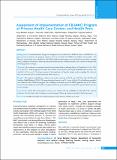Please use this identifier to cite or link to this item:
https://hdl.handle.net/20.500.14356/905| Title: | Assessment of Implementation of CB-IMNCI Program at Primary Health Care Centers and Health Posts |
| Authors: | Parajuli, Surya Bahadur KC, Heera Luitel, Anish Poudel, Rasmita Rai, Prakash Pyakurel, Prajjwal |
| Citation: | ParajuliS. B., KCH., LuitelA., PoudelR., RaiP., & PyakurelP. (2022). Assessment of Implementation of CB-IMNCI Program at Primary Health Care Centers and Health Posts. Journal of Nepal Health Research Council, 20(02), 447-453. https://doi.org/10.33314/jnhrc.v20i02.4108 |
| Issue Date: | 2022 |
| Publisher: | Nepal Health Research Council |
| Keywords: | CB-IMNCI Health Post Implementation Nepal Primary Health Care Center |
| Series/Report no.: | April-June, 2022;4108 |
| Abstract: | Abstract Background: Community-based integrated management of neonatal and childhood illness (CB-IMNCI) is a government-run priority one program aimed to decrease neonatal and childhood morbidity and mortality. The objective of our study was to identify the CB-IMNCI implementation gap in terms of health care providers’ training status, availability of medicines, follow-up visits and clinical outcome at Primary Health Care Centers and Health Posts of Morang district of Nepal. Methods: We conducted a community based cross-sectional study in Morang district of Nepal from 25 Oct 2021 to 25 Jan 2022. Ethical approval was taken from ethical review board of the Nepal Health Research Council. We enrolled 9 (53%) out of 17 local governments of Morang district of Nepal by simple random sampling. The collected data was entered in MS Excel and analyzed by SPSS version 23. Results: The majority of healthcare workers were in their early age of 26-35 years (57.2%), male (85.7%) and Auxiliary Health Workers (78.6%). The mean duration of practice was 15.1 years. Only 46.5% of healthcare providers were trained for the CB-IMNCI program. The availability of medicine as per CB-IMNCI guideline was 52.9%. There was no record available for total number of required follow up, total number of actual follow up and clinical outcome in last 6 months. Conclusions: About half of the human resources were trained with the availability of only half of the required medicines. We also found a lack of adequate record-keeping of follow up of patients and their clinical outcomes. Keywords: CB-IMNCI, Health Post, Implementation, Nepal, Primary Health Care Center |
| Description: | Original Article |
| URI: | http://103.69.126.140:8080/handle/20.500.14356/905 |
| ISSN: | Print ISSN: 1727-5482; Online ISSN: 1999-6217 |
| Appears in Collections: | Vol 20 No 02 Issue 55 April-June, 2022 |
Files in This Item:
| File | Description | Size | Format | |
|---|---|---|---|---|
| 4108-Manuscript-29695-1-10-20221103.pdf | Full Article. | 202.43 kB | Adobe PDF |  View/Open |
Items in DSpace are protected by copyright, with all rights reserved, unless otherwise indicated.
